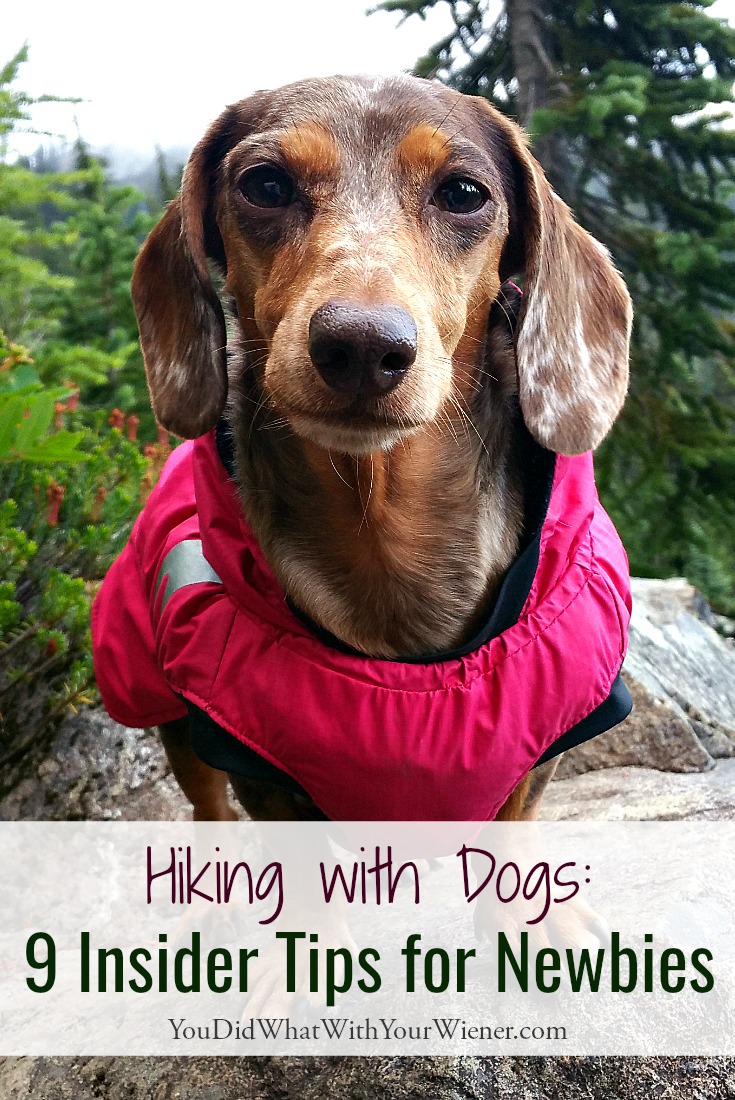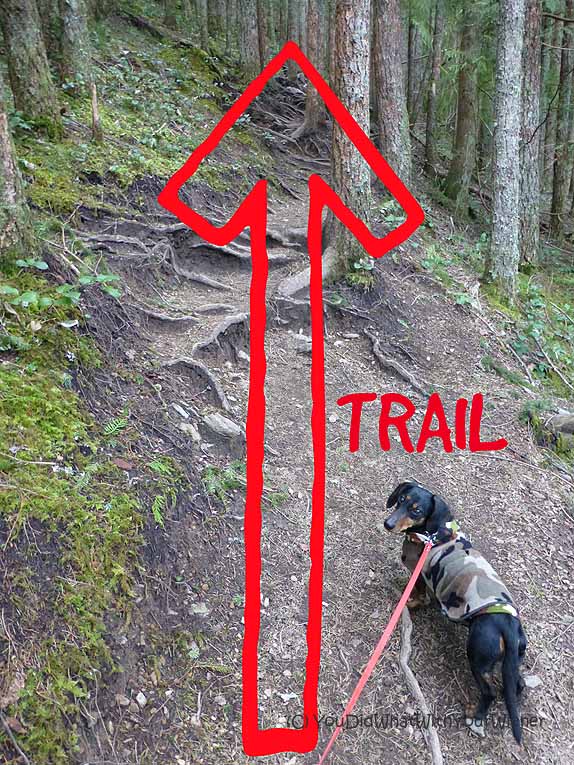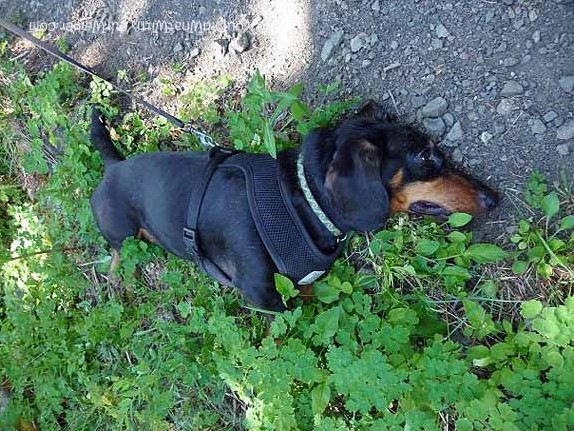9 Expert Tips for Hiking with a Small Dog
So you’ve discovered the wonders of hiking with your small dog? Good for you!
UPDATED: November 28, 2022
I’ve been hiking with my small dogs (Dachshunds) for over 16 years so I can attest to how awesome it is.
I can also attest to how overwhelming it can be everything there is to know about hiking with a dog.
Also, although there is a lot of information about there about hiking with dogs, not all of it applies to small dogs.
Hiking with a small dog has it’s advantages and, while there is significant overlap, there are special considerations needed when hiking with a little dog.s

IHere are my tips to get you started on on the right paw if you are new to hiking with your small dog.
If you’ve already been doing it, maybe you will learn something you didn’t know.
What You Need to Know When You Hike with a Small Dog
Whether you’re a newbie or just someone who wants to learn more, it can feel intimidating to ask questions in a group or forum of people you perceive to know it all.
I’ll address some of the more basic, but very important and not always mentioned, points so you don’t have to ask.
1) Make Sure Dogs Are Allowed on the Trails
There is nothing worse than getting excited about a hike, driving all of the way there, and finding a “no dogs allowed” sign.
Before you start trip planning, make sure you check the rules and regulations to see if dogs are even allowed on the trail.
Here are the general rules for differing state lands.
National Parks (Federal Jurisdiction)
While there are a (very) few dog friendly US National Parks, dogs are not allowed on trails as a general rule. (note: dogs are allowed in many Canadian National Parks).
However, just because the National Park’s policy on dogs is restrictive, that doesn’t mean that you can’t bring your dog and still enjoy yourself.
Check out these crucial tips for visiting a National Park with with your dog (most people don’t know #2).
Forest Service land (Federal jurisdiction)
Dogs are allowed on all Forest Service lands in all States (at least I am not aware of any and I have traveled to many states).
Since dogs aren’t allowed to hike in most National Parks, and most National Parks are surrounded by Forest Service lands, finding trails adjacent to National Parks is a great way to experience the area with your dog.
Another bonus of hiking on Forest Service land is that you are more likely to find a trail that allows hiking with your dog off leash here.
Department of Natural Resources (DNR) and Bureau of Land Management (BLM) land (State jurisdiction)
Dogs are allowed on almost all trails owned by these two entities.
BLM land is another place you are more likely to find trails that allow you to hike off leash with your dog.
State Parks (State Jurisdiction)
The rules regarding dogs can vary from state to state when it comes to State Parks.
For example, dogs are allowed on trails in almost all State Parks in Washington State but there are many restrictions regarding dogs in California State Parks.
It’s best to do thorough research, or call and ask, before you go.
Note: most of these land types will require some kind of parking pass and/or entry fee and, unless you purposely buy a combined pass (if available), you will need to make sure you know what agency manages the land you are hiking on to know which pass to purchase and display.
2) How to Tell How Difficult a Trail Is

Before you decide to hike a particular trail, you’ll want to gauge how hard it is first.
The main factor in determining this is knowing how long it is and how steep it is.
Most trail websites and descriptions will list the mileage. But is that mileage one-way or round trip? Make sure to read the fine print so you know.
Obviously, if the website only lists one-way distance, you will need to double that to get the total hiking distance.
You’ll then want to look at the elevation GAIN and divide that number by the ONE WAY mileage of the trail.
That will tell you, roughly, how many feet per mile you will ascend while hiking.
Anything under 200 ft/mile is pretty easy. Anything over 500 ft/mile is pretty tough. In between that, it may or not be a challenge depending on your fitness level.
But don’t forget to read the trail description and trip reports too! The elevation gained per mile calculation DOES NOT tell the whole story.
More often than not, the trails are a series of ups and downs. You may be hiking uphill more feet (of elevation gain) than your total elevation gain number indicates.
Some trails are flat for a couple miles and then you make up all of the elevation gain in a short distance.
For example, we have a local trail that is listed as 8 miles round trip (so 4 miles one-way). The elevation gain is 1,600 feet. That “works out” to 400 feet of elevation gain per mile. That doesn’t sound too bad.
However, if you read the trail description, you will find out that the beginning of the trail is pretty flat and you gain 1,200 of those vertical feet in a mile. Yikes!
3) The Hike Will Take You Longer Than You Think
Everyone hikes at a different speed depending on fitness, how steep the trail is, terrain, and personal preference.
The average hiking pace is usually around 2 mph. However, someone new to hiking may walk slower.
There are many reasons the hike could take longer than you think:
- You may want to take a break or 3 on your way up
- You may feel unsure of your footing so you might walk slower to navigate tricky terrain
- Your expectations don’t match reality and you hike slower than you think
- You may end up stopping to take pictures more often than you thought
- Unexpected things could pop up
When calculating expected trip time, it’s always better to over-estimate.
I always add at least 1 hour to the total time I think it will take me to hike a particular distance. If you are new to hiking, you may want to add 2 hours.
4) Make Sure You and Your Dog Are Properly Prepared

Being prepared means:
Making sure you and your dog are physically fit enough for hiking
If you aren’t, you could risk having a miserable time and/or getting injured.
To prepare for hiking season, make sure you and your dog are used to regular walks on varying terrain.
You may want to go to the gym to strengthen your legs and core.
While you’re getting your dog ready for hiking, you might also want to have them do some conditioning exercises.
Wearing the right clothing
For you, the most important piece of clothing is footwear.
You can’t get anywhere without healthy feet so get a sturdy, comfortable pair of hiking boots/shoes.
I also highly, highly, highly suggest wearing wool or synthetic socks.
As for your clothing, avoid cotton, wear layers, and consider bringing a rain jacket.
In most cases, your dog doesn’t need anything but a leash and collar or harness (I always suggest using a harness instead of a collar for safety).
However, depending on the weather and terrain, they may need a dog jacket, cooling vest, boots, or paw balm for foot protection.
You may also want them to carry a backpack.
Bringing the right gear
My theory is that it’s better to bring more than you need instead of less.
Check out this article to see what I bring when I go day hiking with my dog.
Bringing enough food and water
Bring as much as you think you and your dog will need and then bring a little extra.
You may eat more because you are burning a lot of energy and drink more because you are sweating.
You also want to have a little reserve in case you get delayed for some reason.
5) Safety Starts Before You Go
When people think about hiking with their dog, they sometimes envison scary things that could happen on the trail.
But ensuring you and your dog stay safe starts before you even leave the house.
- Pick a trail that is in-line with your fitness level and ability (and that of everyone in your party)
- Check the weather forecast before you go (and avalanche danger if snow is on the ground)
- Bring a first aid kit
- Take a human and pet first aid course
- Bring the 10 essentials (I cover most of these in my packing list linked to above)
- Tell someone where you will be
- Make sure you know what to do if you and your small dog encounter wildlife
- Know what toxic plants are found on Pacific Northwest Trails (or wherever you’re hiking)
6) Check in With Your Dog Regularly on the Trail
Once you’re on the trail, there are things you should be doing in the moment to ensure your small dog stays comfortable and healthy.
Dogs are very likely to follow us to the end of the earth and then some. They’ll push themselves to keep up with us even if they are exhausted or injured.
It’s important to check in regularly with your dog to make sure they are comfortable and safe.
- Make sure you know the signs that your dog has reached their physical limit and is tired.
- Regularly check your dog’s feet for torn paw pads, for abrasions, punctures or things stuck between the pads on their paws.
- Check them a few times while on the trail to make sure they aren’t getting chafed by their harness.
- Make sure they (and you) stay hydrated.
Expert tip: Give them more water than you think they need. They won’t always drink when they need it so consider flavoring the water with something yummy to entice them to drink.
7) There Are Etiquette Rules (Some Unspoken)

While everyone has a right to enjoy the outdoors as they see fit, there are some universal rules that are designed to help keep order in the woods.
These are some of the most basic etiquette rules:
Downhill hikers should yield to uphill hikers
If the trail is not wide enough for two people, or two people and two dogs, to pass easily (it rarely is here in the Northwest), the uphill person should offer to step aside and let the person hiking uphill pass.
They may decline because they want to take a break though and let you pass them instead. Just be sure to offer.
Hikers should yield to horses
Step off the trail to let horse riders pass.
Keep in mind that some horses are spooked by dogs, especially if they bark, which can be unsafe for everyone.
It’s never a bad idea to ask the rider how they would like you to let them pass for their horse’s safety.
Bikers should yield to hikers BUT…
Technically, this is true. In reality, a biker might not see you until they are right on top of you because they are moving faster.
Also, they may be riding up a steep hill and it would be very difficult for them to get off their bike and get started again.
Be sure to listen for bikes and be willing to step aside if it seems reasonable. It’s better to be safe than right.
Follow the leash laws
If the law in the area is for your dog to be leashed, they should be.
Breaking the rules can lead to fines in some areas, it can lead to dog fights on the trail, and other trial users will expect the dogs they encounter will be restrained (maybe they are allergic or have an anxious dog that doesn’t like being approached by a strange dog).
At the very least, if you choose to hike with your small dog off-leash anyway, leash your dog or hold onto their harness when you see others approaching.
Keep your music to yourself
This one is an element of the Leave No Trace Principles below – noise pollution is a real thing – but it deserves to be called out on it’s own.
If you choose to listen to music through a speaker instead of headphones, make it just loud enough that only you and your party can hear it.
Many people hike to escape “artificial” noise and you may get some really annoyed looks (or comments) if you “force” your music on them.
8) Leave It Like You Found It
A lot of people use hiking trails. In some areas, like Western Washington, trails may see HUNDREDS of dogs and people in one weekend.
All of the tiny actions those people make can leave a big impact on the area.
In 1994, the Leave No Trace Center For Outdoor Ethics was founded and established a set ethics promoting conservation in the outdoors called Leave No Trace Principles.
There are 7 Principles but you only have to remember to ask yourself this ONE question – “Will someone be able to tell that we were here?”
Using these principles when hiking with dogs means:
- No picking flowers
- No moving rocks
- No littering
- No cutting trail switchbacks (leaving the established trail to take a shortcut)
- No letting your dog dig holes or trample fragile vegetation
- No leaving your dog’s poop in the woods (that especially includes bagging it and leaving it on the side of the trail).
9) Don’t Use Retractable Leash
It’s common for a lot of small dog owners to use retractable leashes when walking their dog.
I don’t recommend retractable leashes. Especially not for hiking.
- Retractable leashes can be tripping hazards because it’s hard for people to see them.
- Other dogs, horses, bikers, and wildlife can get caught up in them if they cross the trail between you and your dog
- They can cause cuts and “rope” burns if they retract fast against someone’s skin
- You have less control over your dog when you use a retractable leash
I admit I used one with my first Dachshund Chester for a long time but that was before I was aware of the dangers, and the dog behavior issues (like running up to another dog without permission), retractable leashes can invite.
We use a 6-foot static leash.
My favorites are made from Biothane (coated webbing – “vegan leather” and waterproof).
Final Thoughts
Sure, even with the best of intentions, you can’t prevent all of these things from happening in all situations but be conscious and don’t knowingly do any of these things.
These 9 simple tips can elevate your knowledge of hiking with small dogs.
Perhaps your will feel like the expert and be able to advise others.
Knowing these things will also help make the hike more enjoyable, and safer, for both you and your dog.

About the Author
Hi, I’m Jessica. I’ve been studying the Dachshund breed since 2007, owned 3 of my own, and shared in the lives of thousands of others through their owner’s stories. When I’m not sharing what I know on this blog, you can find me hiking, camping, and traveling with my adventurous wiener dogs.

Never knew about the etiquette of downhill hikers giving way to uphill hikers. Feels odd since the downhill hiker might have less ability to stop easily if it’s a steep trail.
On a boat, the etiquette when passing under a drawbridge is for vessels against the current to give way to vessels going with the current because going with the current (like walking downhill) gives you less control.
Either way, the point you made is to just be considerate to others on the trail and that is always a good reminder. Especially for people hiking with dogs.
Yes, it does seem a bit counter-intuitive. I think that’s why people always forget. And it only complicates things when you are coming downhill, stop, and most people going uphill waive you by because they want the break.
What kind of foods we needed to carry , if my dog is not favorite of eating pedigree. She likes eating butter and chicken , sometimes milk ,it is cross Pomeranian.
Hi Nikkibelle. The food I carry depends on how long we will be out hiking. If it’s just for a day trip, I just bring some dog treats. The treas vary but they are treats made for dogs. If we are going hiking overnight for one night, I sometimes just bring dog kibble. If we are going to be out backpacking several days, I bring dehydrated raw dog food because it’s lighter weight and easier to carry. A couple of my favorites are Small Batch, Stella and Chewys, and Primal. Hope that helps.
Thank you Jessica
This is a great post! I am planning to go hiking with my dog this year. It’s really helpful for me reading the information you share. Thank you so much!